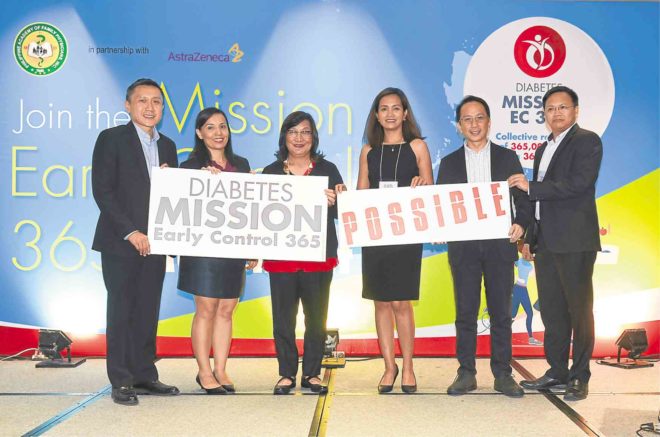
The Philippines now ranks No. 11 in the world with the highest prevalence of Type 2 diabetes. By 2030, it is expected to be among the world’s Top 10 producers of diabetics. Diabetes is currently the eighth leading cause of death in the country, causing more deaths a year than breast cancer and acquired immunodeficiency syndrome (AIDS) combined, with two out of three people with diabetes dying from heart disease or stroke.
Eight out of 10 Filipinos with Type 2 diabetes struggle to achieve their blood glucose levels. If diabetes is managed properly, complications can be delayed or prevented.
This is according to Dr. Araceli Panelo, chair of the Institute for the Studies of Diabetes Foundation Inc., during the launch of the Philippine Academy of Family Physicians and AstraZeneca “Mission: Diabetes Early Control 365.”
Campaign
The nationwide campaign aims to promote early detection of diabetes and lowering of HbA1c, a key marker of Type 2 diabetes control that indicates a patient’s average blood glucose over a period of two to three months. Lowering a patient’s HbA1c can reduce a patient’s risk of serious Type 2 diabetes complications such as heart disease, stroke, blindness, limb amputations and kidney failure.
Panelo said diabetes is responsible for more than 100 amputations a week. It is the leading cause of preventable sight loss in people of working age, and it is a major contributor to kidney failure, heart attack and stroke.
The mission is to reach a collective reduction of 1,000 HbA1c percent per day in 365 days for a total of 365,000 HbA1c percent reduction, said Dr. José Carlos Miranda, steering committee member of “Mission: Diabetes Early Control 365.”
HbA1c is generally accepted as the single, most prominent and independent parameter of metabolic control, a risk factor for the development of diabetic complications, and is widely used as a treatment goal in disease management, Panelo said.
The mission, launched last Sunday, offered free HbA1c testing, lipid screening, blood pressure check, weight and BMI management and BMI analysis. Cities and provinces covered by the mission include Taguig, Parañaque, Marikina, Lipa City, Bulacan, Pangasinan, Baguio, Cavite, Batangas City, Cebu, Iloilo and Cabanatuan.
“Our goal is to promote effective blood glucose control and prevent serious Type 2 complications among Filipino diabetics,” said Dr. Justin Chin, country president of AstraZeneca Phils.
The mission is harping on early control to prevent many complications correlated with diabetes, such as angina, cardiac failure, stroke, retinopathy (diabetes is the leading cause of blindness), renal replacement therapy and amputations.
Metabolic memory
“There’s a metabolic memory. Once the complications set in we cannot bring you back to zero complications. We may reduce or slow down its progress, but there’s no going back. However, if we can control early on in the disease, the outcome is much better,” said Dr. Aurora Macaballug, board member, Philippine Society of Endocrinology, Diabetes and Metabolism.
“Mission: Diabetes Early Control 365” will focus on the four “Ms” of optimal Type 2 diabetes prevention and management: Motivation, Mentoring, Monitoring and Medication.
“We have to give patients a good quality of life, like making a choice between pasta, rice or bread. Most patients will appreciate that. Goals must be doable and achievable or else it will fail,” Macaballug said.
Diet, lifestyle modification
It is imperative, for instance, that patients make a diet and lifestyle modification. One cannot go without the other, she added.
Eat right. Limit food that are high in saturated fats or trans fats, such as fatty cuts of meat, fried food, whole milk and dairy products made from whole milk, cakes, candy, cookies, crackers, pies, lard, shortening, margarine and nondairy creamers. Increase your fiber intake by eating whole grain food, such as oatmeal, whole grain rice, whole wheat bread, bagels, pita bread, tortillas, breakfast cereals with 100 percent whole grains. Eat a variety of fruits and veggies every day.
“Choosing the right food, the right amount and the right frequency is the key to a successful diet,” Macaballug said.
Be active. It is recommended to have a moderate-intensity physical activity for at least 30 minutes five or more days a week, such as brisk walking, dancing, swimming, yoga, tai chi or cycling.









































